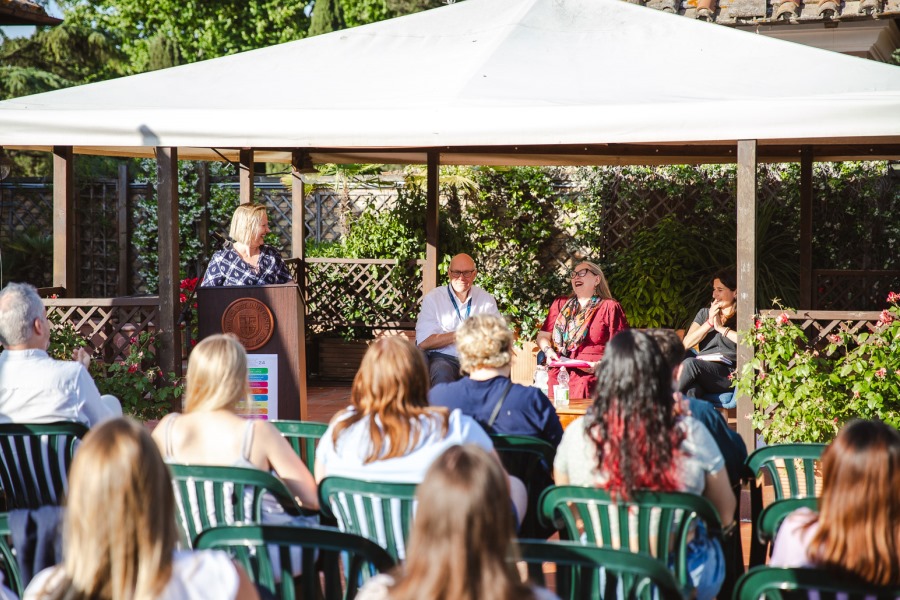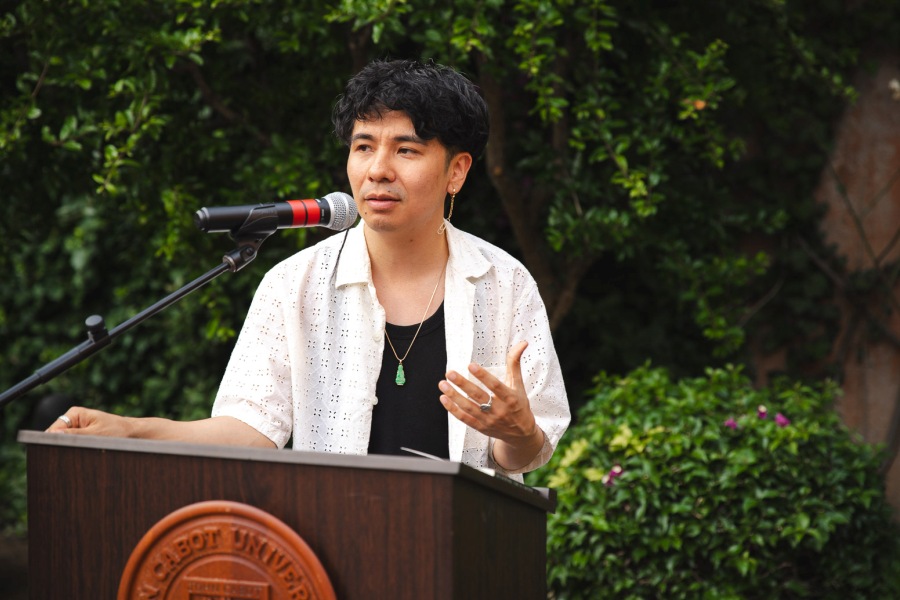Witchcraft Throughout History: A Lecture by Fabrizio Conti

Professor Fabrizio Conti
John Cabot University’s History and Humanities Department launched the “Humanisms and Beyond Lecture Series” with an online talk by History Professor Fabrizio Conti called “Classical Roots of Beliefs in Witchcraft: A Multidisciplinary Liberal Arts Topic,” on November 17, 2020.
The “Humanisms and Beyond” Lecture Series, organized by Professors Fabrizio Conti and Stefan Lorenz Sorgner, aims at fostering reflections on the historical and contemporary developments of concepts such as Humanism and the Liberal Arts. Says Professor Conti, “These are concepts of central relevance for John Cabot University. ‘Humanistic Studies’ is the name of one of our majors. However, all of these concepts have changed over time, and there are various interconnections between all of them, as this lecture series aims at highlighting.”
Professor Conti explained how Classical culture played a role in shaping witch beliefs. He pointed out how witchcraft as it is understood today, and the specific set of elements that characterize it, emerged during the first half of the 15th century. In earlier medieval times, witchcraft was part of the folkloric tradition and mostly regarded as a superstition. Witches were believed to be humans, generally females, who employed magic to cause misfortune or injury. Thought of as internal threats to the community, they were often targeted by neighbors and relatives.
According to the American historian Brian Levack, there are some elements that were always present in witchcraft cases, such as the pact with the devil, which was carried out through a sort of formal ceremony, the Sabbath, a nocturnal assembly where infanticide and naked dancing were performed, and the idea that witches could fly. The practice of metamorphosis was also present, albeit less popular. “I believe witchcraft as an historical-cultural phenomenon offers the possibility to put together different elements pertaining to diverse traditions and domains. In turn, this could be considered as a complex type of intellectual, cultural, scholarly gym that gives one the possibility to exercise his or her own critical thinking,” said Professor Conti.
Witchcraft in ancient times
Professor Conti said that witchcraft was present in classical traditions as well, including those of Ancient Greece and Rome. In Book X of his Odyssey, Homer tells the story of Circe, a sorceress who had a vast knowledge of herbs and potions, and the ability to transform those who offended her into animals. In his play Medea, ancient Greek tragedian Euripides tells the story of the title character, a sorceress who murders her own children, embodying the cross-cultural trope of the child-killing demon. In Greek mythology, the Lamia was a woman who kidnapped and murdered children, the Gello a female ghost who harmed them, and the Mormo a spirit who was once a woman and who devoured her own kids.
The trope of the child-killing demon was present in Mesopotamia as well. In the third century BCE, the Sumerian tradition featured Lilith, who was associated with lethal nocturnal birds of prey and believed to be responsible for the inexplicable deaths of children. The Babylonian demon Lamashtu was thought to menace women during childbirth and torture babies, and an incantation against her has been maintained up to this day. The ancient Roman strix (plural striges) bore a resemblance to the demon Lilith and was a night bird preying on children and drinking their blood.
In his Epodes, the ancient Roman poet Horace writes about Canidia, a sorceress who kidnaps a baby with the intention to use parts of his body to make a love potion that would lure her lover Varus back to her. Horace writes about Lamiae devouring children in his Ars Poetica, whereas Petronius mentions striges attacking the corpse of a child in his Satyricon. Lucan recounts the story of Erichto, a bloodthirsty and necrophiliac Thessalian seer in the epic poem Pharsalia. In his novel Metamorphoses, Apuleius talks about Pamphile, a sorceress who turns into an owl.
Witchcraft in modern times
Professor Conti explained that between the 15th and 17th centuries, 100 thousand witches were persecuted in Europe, and of these, 50 thousand were executed. According to modern statistical analyses, 75 percent of witches were women, but there were significant regional variations. Northern countries such as Iceland, Estonia, and Russia mostly prosecuted men, whereas Finland and some areas of France targeted both sexes.

A Coven of Witches
In their treatise on witchcraft called The Malleus Maleficarum (1486), the inquisitor Heinrich Kraemer states, “The belief that there are such beings as witches is so essential a part of the Catholic faith that obstinately to maintain the opposite opinion manifestly savors of heresy.” Italian philosopher Gianfrancesco Pico della Mirandola’s Strix, sive de ludificatione daemonum (1523) popularizes the ideas proposed in the Malleus Maleficarum. The work devotes less attention to magical harm than to the corporeality of demons, attempting to demonstrate that witches’ interactions with them were real.
“There is little doubt that in every continent of the world, the majority of recorded human societies have believed in, and feared, an ability by some individuals to cause misfortune and injury to others by non-physical and uncanny (magical) means: this has been the most striking lesson of anthropological fieldwork,” writes English historian Ronald Hutton in his book The Witch (2017). “The advent of Humanism coincided with a revival of sorcery persecution. (…) at precisely the time when humanistic ideals and values were replacing traditional medieval beliefs, the city (Florence) was burning its heretics and its sorcerers,” writes American history professor Gene A. Brucker in his book Sorcery in Early Renaissance Florence (1992).
In traditional non-Western societies, the practice of shamanism was present. A shaman refers to someone who is believed, or claims, to communicate regularly with spirits, and does so for the benefit of other members of society. Generally, communication with spirits is performed in an altered state of consciousness, commonly described as trance. Italian historian Carlo Ginzburg incorporated elements of shamanistic origin rooted in folk culture in his works I Benandanti (1966) and Storia notturna (1989).
Witch-hunts started to fade away in the course of the 17th century. The development of different philosophical and epistemological frameworks, scientific advancements, changes in juridical rationality as well as in social patterns played an important role. For instance, the Roman Inquisition published new guidelines in 1620 making the prosecution of alleged witches more difficult. The secular and religious elites were slowly losing interest in witches and getting ready for pursuing new social targets.
About the Speaker
Professor Conti earned his Ph.D. in History and Medieval Studies from the Central European University in Budapest (2011). He also earned degrees from the School of the Vatican Secret Archives and the Pontifical Institute for Christian Archeology. After several teaching experiences both in Italy and abroad, and after having taught at the Ohio State University in 2015, he is currently a lecturer in History at JCU. His publications include the monograph Witchcraft, Superstition, and Observant Franciscan Preachers: Pastoral Approach and Intellectual Debate in Renaissance Milan (Brepols, 2015), and the edited volume Civilizations of The Supernatural: Witchcraft, Ritual, and Religious Experience in Late Antique, Medieval, and Renaissance Traditions (Trivent, 2020) with a foreword by Teofilo F. Ruiz (UCLA).





